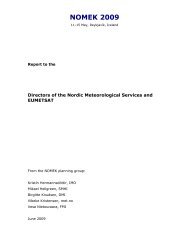International Symposium on Mitigative Measures against Snow ...
International Symposium on Mitigative Measures against Snow ...
International Symposium on Mitigative Measures against Snow ...
Create successful ePaper yourself
Turn your PDF publications into a flip-book with our unique Google optimized e-Paper software.
<str<strong>on</strong>g>Internati<strong>on</strong>al</str<strong>on</strong>g> <str<strong>on</strong>g>Symposium</str<strong>on</strong>g> <strong>on</strong> <strong>Mitigative</strong> <strong>Measures</strong> <strong>against</strong> <strong>Snow</strong> Avalanches<br />
Egilsstaðir, Iceland, March 11–14, 2008<br />
Extreme runout distance of snow-avalanche transported<br />
boulders linked to hazard assessment;<br />
some case studies in Northwestern and Northern Iceland<br />
Armelle Decaulne 1,2,* , Þorsteinn Sæmundss<strong>on</strong> 2 and Helgi Páll Jónss<strong>on</strong> 2<br />
1 University Clerm<strong>on</strong>t 2, CNRS UMR6042 Geolab, 4 rue Ledru, F-63057 Clerm<strong>on</strong>t-Ferrand cedex 1, FRANCE<br />
2 Natural Research Center of Northwestern Iceland, Aðalgata 2, IS-550 Sauðárkrókur, ICELAND<br />
*Corresp<strong>on</strong>ding author, e-mail: armelle.decaulne (at) gmail.com<br />
ABSTRACT<br />
We propose and quantify an α/β ratio for boulders transported by snow avalanches based <strong>on</strong><br />
the proporti<strong>on</strong>al property of two topographic parameters (i) runout distance α and (ii) path<br />
steepness β. These two parameters were determined from geomorphological investigati<strong>on</strong>s in<br />
back country areas where no human infrastructures and major activities have occurred. We<br />
suggest that the applicati<strong>on</strong> of the proposed α/β ratio within inhabited areas helps to determine<br />
the expected runout of potential maximum magnitude snow avalanches and thus potentially<br />
improves hazard z<strong>on</strong>ing for the mitigati<strong>on</strong> of avalanche danger in populated areas. We tested<br />
this approach in areas with towns and villages exposed to avalanche danger. Our results<br />
c<strong>on</strong>firm that large snow avalanches have already occurred in some areas, while such<br />
avalanches have to be expected in other areas where no or <strong>on</strong>ly smaller events have yet been<br />
recorded.<br />
1. INTRODUCTION<br />
Am<strong>on</strong>g all terrestrial natural hazards occurring in Iceland, including earthquakes, volcanic<br />
activity, floods, storms and mass movements, snow avalanches caused the main toll in human<br />
lives and ec<strong>on</strong>omic loss during the last century (Jóhanness<strong>on</strong>, 2001; Jóhanness<strong>on</strong> and<br />
Arnalds, 2001). Thus, snow avalanches represent a significant hazard in Iceland for<br />
settlements and vital infrastructures (e.g. transportati<strong>on</strong> corridors). However, since 1995,<br />
numerous mitigati<strong>on</strong> measures have been undertaken to protect the threatened areas and<br />
extensive modeling approaches have been developed (see the numerous work available for<br />
several sites at http://www.vedur.is/ofanflod/haettumat/) (Magnúss<strong>on</strong>, 1996, 2003; Bernharðsdóttir,<br />
2001).<br />
Based <strong>on</strong> our observati<strong>on</strong>s from back country field investigati<strong>on</strong>s, we were able to recognize<br />
the maximum downhill extensi<strong>on</strong> of snow avalanches. Boulders deposited by snow<br />
avalanches with extreme runout distances were selected to determine the minimum extreme<br />
runout of the avalanches.<br />
Topographic parameters such as the extreme runout and the path steepness are used to<br />
establish a proporti<strong>on</strong>al relati<strong>on</strong>ship that enables the transfer of the observed data from the<br />
back country sites into areas where human activities (e.g. agriculture, c<strong>on</strong>structi<strong>on</strong> sites) have<br />
displaced or removed valuable geomorphic indicators (mainly boulders deposited by<br />
avalanches). We suggest that our approach will c<strong>on</strong>tribute to enhance the safety of people in<br />
threatened areas by supplying pertinent informati<strong>on</strong> for hazard z<strong>on</strong>ing, because (i) even if<br />
Decaulne and others 131











